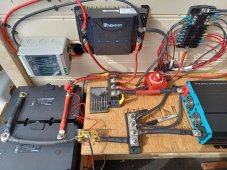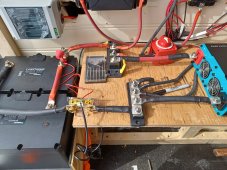From left to right...
Do those batteries have a smart BMS?
If not you probably want to add a shunt.
Yes, I did forget the shunt, but I have one available.
Your inverter alone can pull ~240 amps from those batteries and they are only rated for 200 continous amps aggregate.
Add the dc fuse block loads to that number and its too high for the batteries.
The only thing running off the inverter would be the water heater with 1440 W. The fuse block is well under 50. We bought the 2000W inverter to have for the future if upgrade is needed.
Would we be ok for our current scenario with our 200 Amp Battery bank?
Rotate the battery pack 180 degrees
That way the battery terminals line up with the inverter terminals
We can certainly do this but what is the reasoning behind it? We are new to all of this and trying to make sense out of it
The amp ratings for the busbar is in continuous amps
The busbar is rated for 300 amps continuous
300 amps continuous / .8 fuse headroom = 375 fuse_block amps
Each fused branch position is rated for 240 amps continuous
240 amps continuous / .8 fuse headroom = 300 fuse amps
We were not aware that the 240 continuous amps can run thru EACH of the branch positions. We thought that the fuses on the branches combined could not exceed 300 amps. (we thought 200 A inverter fuse plus 80 A fuse box was just under 300 A and therefore did not add the charge controller to the bar) Thank you for the learning experience.
2000 ac watts / .85 conversion factor / 10 volts low cutoff = 235.294117647 continuous inverter amps
300 busbar amps - 235.294117647 inverter amps = 64.705882353 continuous fuse_block amps
You can fuse the fuse block feeder circuit as high as 75 amps with 6 awg wire
We are running 4 awg with 80 amp fuse for the fuse box. So we should be fine.
You should fuse the inverter circuit at 250 amps with 2/0 wire
You can fuse the dc2dc charger as high 60 amps with 6 awg wire.
We are using 60 amp fuse with 4awg wire.
You can fuse the wire from the starter_battery as high as 80 amps with 6 awg wire.
Put the fuse at the starter battery end of the wire.
We have it fused with a 60 amp at the starter battery end with 4 awg wire.
Move the disconnect switch to the fuse_block feeder circuit.
will do.
I would like to congratulate you on the selection of the blue sea 5196, its very well suited to the application.
Hope the negative busbar is similarly rated and similar quality.
It is indeed, it is a bluesea 250 amp
I just thought about an issue with my negative connections. I was wondering if I could connect the negative from the starter battery to the negative of the solar controller and then run from there to the common negative busbar? What are your thoughts?
Right now I have it connected directly to the busbar but I do not have any position left to connect negative from the solar controller to the busbar as well.
Thank you for your time and input.







